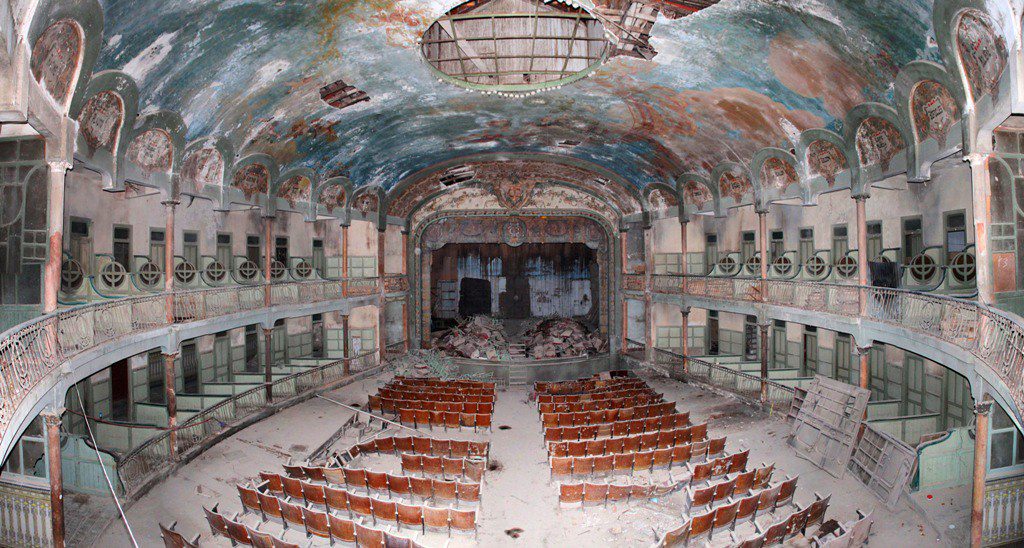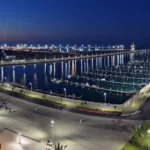
Some buildings retain a mythical aura as if they had been built with the aim of transcending. They are places that keep the secrets of an immeasurable past behind them and thousands of anecdotes. Buildings that defy memory while maintaining their dignity intact, even though their external appearance has been tarnished by the relentless passage of time. The Gran Teatro Cervantes Tanger, in Morocco, is one of them.
Under Spanish ownership, it was the largest and most renowned theatre in the whole of North Africa. Before construction began in 1911, it took shape in the imagination of Esperanza Orellana, her husband Manuel Peña, and the businessman Antonio Gallego, who was determined to build a great theatre for the pride of Tangier. Two years after the laying of the first stone, in a solemn ceremony attended by Hadj Ben Abdessadak, the city’s pasha, the theatre was inaugurated. With all the pomp that a 1,400-seat theatre, an astonishing capacity for the time, deserved.
With its fame, and encouraged by the enthusiasm of the population of Tangier, under international administration, the Gran Teatro Cervantes Tanger began to receive first-class artists and plays, such as Shakespeare’s Othello, which received the applause of a completely devoted Arab and European audience.

Artists on their boards
Well-known artists of the time also performed there, such as the great tenor Enrico Caruso, Estrellita Castro, Imperio Argentina, Juanito Valderrama, Carmen Sevilla, María Caballé, and Lola Flores, without forgetting the opportunity given to local artists, such as Abdeslam Ajenoui and the members of the El Haded company, made up of Muslim actors. It was a time of great splendor, when the sign “No tickets available” hung from the box office before each performance, to the frustration of those who came at the last minute hoping to get a seat.
The plays were joined by private and end-of-year parties and cultural gatherings. Until the 1950s, Grand Teatro Cervantes Tanger continued to make a name for itself on the international stage. As time went by, however, the theatre’s luster and fame faded and it was almost abandoned. The theatre remained open until the 1980s, and in 1993 it provided cultural services for the last time with a photographic exhibition. With its peeling walls, tarnished columns, leaking roofs, the protective angels that had fallen into disrepair, and its boarded-up windows hiding the remains of the original paintwork, few remembered the nights of splendor it had experienced when they passed by the building.
Attempted relaunch
In 2006, in an attempt to revive it, the Spanish Ministry of Culture and its Moroccan counterpart signed an agreement offering it a second chance as a building for cultural activities. A year later, almost 100,000 euros were earmarked for the rehabilitation not only of its external appearance but also of its structure, after it was realized that the building was suffering from architectural damage.

However, it never managed to recover its former splendor, despite the interest of private initiative and the efforts of artists who could not allow such an important building to be lost. Thus, on the centenary of its inauguration, the painter Consuelo Hernández and the writers Jesús Carazo, Mezouar El Idrissi, and Santiago Martín Guerrero tried to save it by raising funds with the book “Un escenario en ruinas. Artistic-literary appeal for the recovery of the Grand Theatre of Tangiers”. And that same year, an exhibition was held at the Instituto Cervantes in Tangiers to recall all that it meant to the city, with the presence of Spaniards living in the city during its years of splendor, who helped to extend its memory for at least a few more months.
Assignment and commitment
In 2019, the Great Cervantes Theatre of Tangier was declared in ruins, and its transfer from Spain to Morocco was materialized in the form of a donation so that the theatre would not end up falling down and being lost forever.
The only condition set by the Spanish state for its cession was Morocco’s commitment to restore the building, fully respecting its original architecture. In addition, it was requested that its name be preserved so that the memory of what it once was would not be lost, and a commitment to maintaining a Spanish component in its cultural program once it reopened its doors.

Three years to regain its splendor
The maximum time limit set for the rehabilitation of the building in the agreement on the transfer of the building is three years. The Spanish government has insisted that it will monitor compliance with the conditions imposed. Although it has indicated that if they are not fulfilled, the agreement will be reverted, the fact is that the text of the transfer does not contain any clause with this condition.
For the time being, and although the theatre has undergone a minor refurbishment to prevent it from falling down, the major works that would restore it to its original shine have not yet begun. In recent months an initiative has been taking shape on the part of the citizens of Tangier which, under the name ‘Holding up what is falling down’, aims to recover the building for theatrical performances and cultural activities. The Gran Teatro Cervantes Tanger is still waiting for its chance to confirm that second halves were always good.







